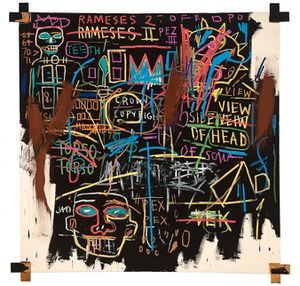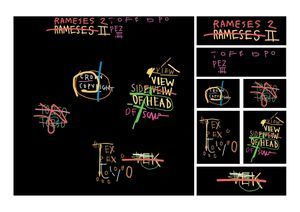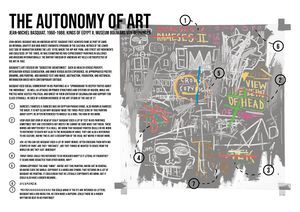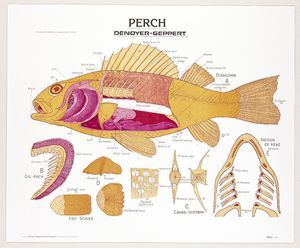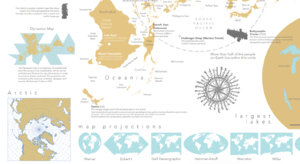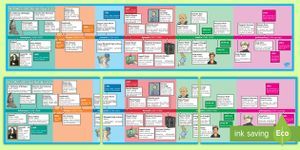User:0923100
== A STORY, ABOUT A STORY, ABOUT ART ==
- a project by Leonie van Dusschoten
== THE THEFT ==
We went to the Boijmans museum. After the presentation at the start of the day, I had no idea what I wanted to do for this course. I just started taking pictures of art that I liked. When I ended up in room 07, I was struck by a painting. I’ve been to the Boijmans museum before, I’ve seen this painting before and every time I seem to fall in love with it. The rest of the time at the museum I spent researching the painting and the artist. The more I got to know, the more certain I got that I wanted to work with this piece.
The painting I am talking about is a painting made by Basquiat. It is called Kings of Egypt II. Within my research chapter I will go into detail about Basquiat and his work. For now I just want to say that he had a strong political and social opinion that he embedded in his work. His work is graffiti-like, containing shapes, words and symbols. It is like he haves a language on his own. This language became the thing I wanted to steal.
== THE COPY ==
The first question you have to ask me is; how do you steal someone’s artistic language? It is more than a style or a signature. It is literally the embodiment of the artist. Artists like Basquiat seem to put a little bit of their soul inside every artwork they make. I cannot talk to Basquiat, get to know him and ask him what the words in his paintings mean. What the symbols mean, if there is really a deeper meaning to every aspect of his paintings or if he doesn’t even know what he is doing himself. All I know with a certainty is that the words on the painting of my choice are his. He put them on the painting. Every painting he made is unique, but the words always return. So they became my copy.
From a frontal photo I traced the words. The reason why I traced them is because I wanted them to be exactly the same, but then made by me. This way I could literally paint over his painting. I took away every other aspect of the painting. I removed the symbols, the shapes, the figures and the lines so I was purely left with what I thought were the words. I kept the redactions and the scribbles that, I think, were part of the words. The result became my copy.
== THE TRANSFORMATION ==
The process of making the copy got me thinking. What I was doing, felt like I was dissecting the painting. Compartmentalizing all things that were visually going on. With all the words I had the same question; “what could he have meant with that?”. This process led me to the idea of my transformation.
When we are in school and we are taught something. Physics, biology, a language and history we dissect the information in parts. You learn about the bones, the organs, the nerve system, the brain, cells and every compartment of the body as an individual before you learn about the whole. When you try to learn about the whole body before you learn about all the individual parts, you will not understand a thing of the information given to you. With art we very often forget to go through this process. We look at an artwork, try to understand what we see, form opinions and make conclusions. We do not translate all the individual parts, we look at the artwork as a whole. By the time we walk away from it, we only have the superficial information and our own conclusion. We have learned next to nothing.
With only looking at “The kings of Egypt” from Basquiat, you completely pass a whole lot of information. I am studying to become a teacher. I often forget to really analyze an artwork myself. It is not functional to dissect every artwork you talk about in class. But maybe it can be made more functional.
I started thinking about making this process more functional. How can we implement this in our classes. How did my own teachers do this with other courses? I remembered the big posters in class. The big maps at geography, the 3D exploding volcano poster, the really old poster of the human body at biology, the -d and ‘t poster-chart at Dutch and the timeline posters at history. Every classroom was filled with educational posters, but not the CKV (cultural and art development class) classroom. This classroom had empty walls. I knew what my transformation was going to be. And educational poster for art-classes.
With this poster I wanted to develop a teaching-method. The students could fill in this method, learning how to reflect on artwork and learning different ways of looking at art.
Link to the teaching method File:METHOD small.pdf
== MY RESEARCH ==
Interview. Quote: Interviewer "why are you angry?" Basquiat "... ... ... I don't remember". [1] Basquiat kings of egypt 2, painting of my choice. [2] Basquiat kings of egypt 3 [3]
Watching interviews like this one [4] I noticed that Basquiat is very careful with his answers. People that interviewed him tried to understand him, understand his motives and come up with terms like " frustration" and "anger" to understand his work. Probably because they know Basquiat his background, his ethnicity, his drug-use. He is stamped some sort of rebel or protester. But as I am watching him, giving answers to questions that seem superficial, I get more and more fascinated by him. He looks a little bit weird due to his hair, but he sounds almost like a child with the wisdom that children often carry. The world is not this complicated place which we often make it to be, it is quite simple actually. It is us, the people, the kings and queens, the consumption, the racism, the love and the hate that make the world complicated. More complicated than it needs to be. Watching Basquiat, watching him think, listening to his answers; simple and pure... I know he could see behind the screens of the play we call "humanity".
For me this does not mean he is not an actor in this play himself. Wisdom does not come with divinity. Even he succumbed to the pleasures of humanity. I don't think it is the wealth, the drugs or the fame that the "27 club", which Basquiat is part of, could not handle. I think it is the wisdom, the knowing and understanding of our world, and the choice to still participate in it. To be succumbed to it. To know everything that is bad about our world, and still being brought to your knees by it, enslaved by it. The true actors of the play we call "humanity" will argue that it is always a choice to give in to drugs, alcohol, wealth and fame. But if we look into our heart of hearts, we know, this is not true. We are all addicted to the role we play. We are all addicted to "fitting in". To making our mark. To belong.
I think Basquiat knew. And I think it is a shame that we do not celebrate him, and people like him, more.
Basquiat his work is political. He addresses social issues like rich vs. poor, fame and racism. He died of an overdose in his art studio when he was only 27. He collaborated with Andy Warhol who he idolized since he was young. He is the first black man to become a famous artist in the western world. Further I searched for examples of educational posters used in classrooms. See images on the right.
== The 7 essential questions during my research. ==
What is the theme I am investigating? I am investigating the parts of wich an artwork exist. In this case those parts are words.
What is my research question? My research question is “how do I get people to analyse these parts, the way I want them to analyse them”.
How am I structuring my research? I structured my research by going to the proces of dissecting the painting myself and researching the meaning that these parts could have. Then I turned into a poster and a method. If I had more time I would test if people looked at my work the way I wanted them to look at my work.
What tools or methods could I/will I use to conduct my research? I digitally traced the artwork using a Wacom tablet. I did this in Adobe Illustrator, for the other graphic work I used Adobe Indesign.
What is the foreseen result? When I started I thought I would be making an ecyclopedia on Basquiat his language. Simply giving a possible explenation for what he could have meant with the words in his painting.
What is the difference between my foreseen result and the result which came through the process? The encyclopia would have been a logic step but didn’t contain an exact purpose. The biggest difference between my first idea and what I actually made is that my end-result serves a clear purpose. It haves a goal.
Is 1. - 6. relevant? Yes, the thing I devoloped is relevant. The way we reflect on art in school is very suppervicial. We are scared to make an in depth evaluation of art with children because “what if they don’t like it, or think it is boring, or make joker about it”. But it is essential for social and cultural development that you learn to reflect in different ways.
